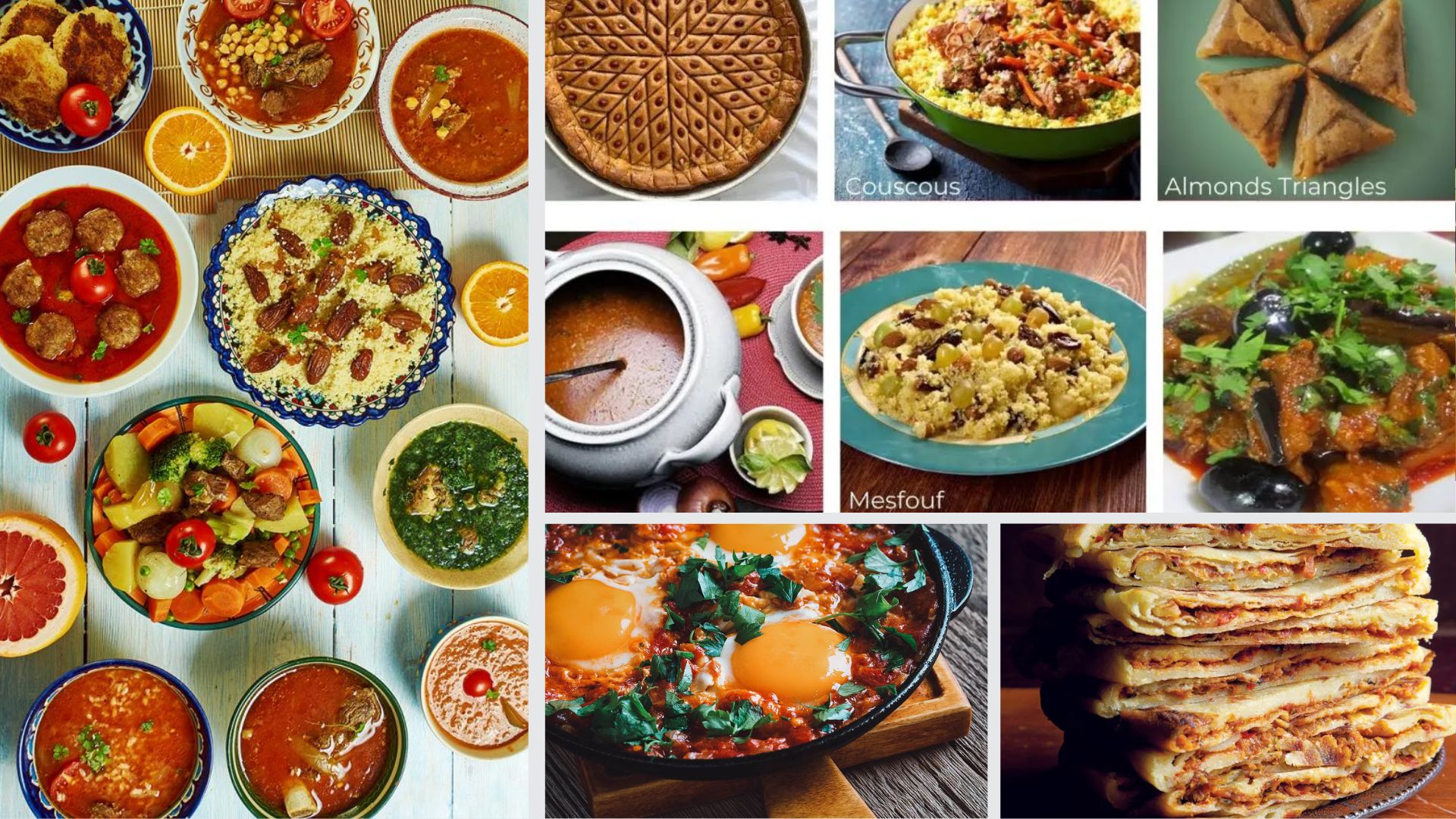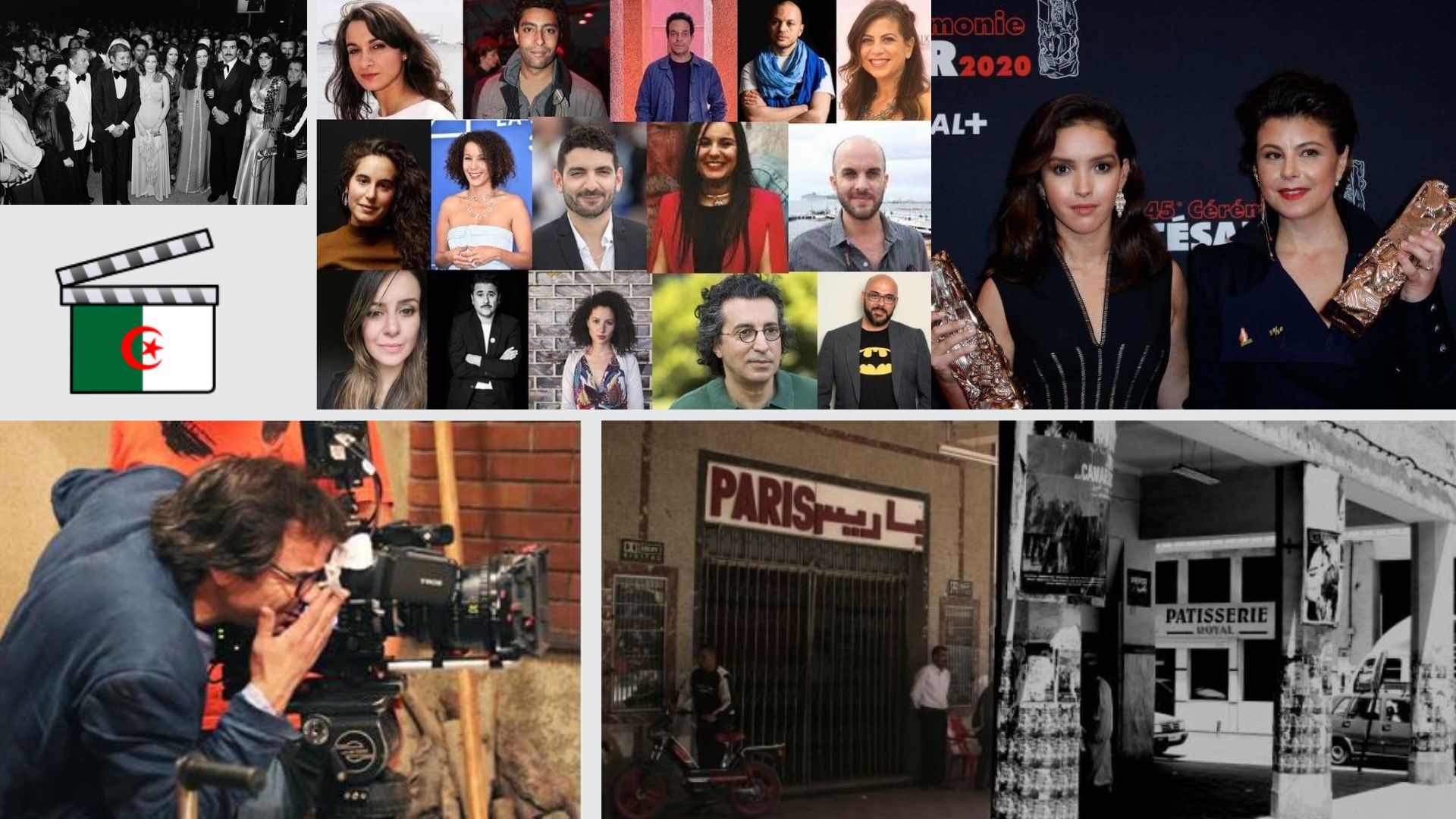Algeria,
the largest country in Africa, boasts a rich and diverse culture shaped by centuries of
history, a blend of indigenous Berber traditions, Arab influences, and French colonial
impact. This cultural tapestry is evident in various aspects of daily life, from clothing
and food to arts and crafts, the film industry, and the economy. Here's an overview of these
elements:
 Traditional Clothing and Attire:
Traditional Algerian clothing varies by region and community but often includes elements like
the djellaba, a long, loose-fitting robe worn by both men and women. Women often wear haiks,
large white veils that cover their bodies, or karakou, an ornate velvet jacket paired with a
long skirt or pants, often adorned with elaborate embroidery. Men might wear a burnous, a woolen
cloak, especially in colder regions. These garments are not only practical for the climate but
also reflect the cultural heritage and artistry of Algerian textiles.
Traditional Clothing and Attire:
Traditional Algerian clothing varies by region and community but often includes elements like
the djellaba, a long, loose-fitting robe worn by both men and women. Women often wear haiks,
large white veils that cover their bodies, or karakou, an ornate velvet jacket paired with a
long skirt or pants, often adorned with elaborate embroidery. Men might wear a burnous, a woolen
cloak, especially in colder regions. These garments are not only practical for the climate but
also reflect the cultural heritage and artistry of Algerian textiles.
 Language and Literature:
Algeria's official languages are Arabic and Tamazight (Berber), with French widely spoken and
used in business and education. Algerian literature has a rich tradition, with writers like
Kateb Yacine and Assia Djebar gaining international acclaim. Yacine's "Nedjma" is a seminal work
that explores themes of identity and colonialism, while Djebar's novels often focus on women's
experiences in Algerian society. Contemporary Algerian authors continue to explore complex
social and political issues through their works.
Language and Literature:
Algeria's official languages are Arabic and Tamazight (Berber), with French widely spoken and
used in business and education. Algerian literature has a rich tradition, with writers like
Kateb Yacine and Assia Djebar gaining international acclaim. Yacine's "Nedjma" is a seminal work
that explores themes of identity and colonialism, while Djebar's novels often focus on women's
experiences in Algerian society. Contemporary Algerian authors continue to explore complex
social and political issues through their works.
 Music and Dance:
Algerian music is as diverse as its people, blending traditional and modern influences. Rai
music, originating in the 1920s, is perhaps the most internationally recognized genre, with
artists like Cheb Khaled and Rachid Taha gaining global fame. Andalusian music, with its roots
in medieval Spain, is also popular, particularly in urban centers like Algiers and Tlemcen.
Traditional dances, such as the Ahidous and Chaoui dances, are performed during celebrations and
festivals, showcasing the rhythmic and vibrant cultural expressions of different regions.
Music and Dance:
Algerian music is as diverse as its people, blending traditional and modern influences. Rai
music, originating in the 1920s, is perhaps the most internationally recognized genre, with
artists like Cheb Khaled and Rachid Taha gaining global fame. Andalusian music, with its roots
in medieval Spain, is also popular, particularly in urban centers like Algiers and Tlemcen.
Traditional dances, such as the Ahidous and Chaoui dances, are performed during celebrations and
festivals, showcasing the rhythmic and vibrant cultural expressions of different regions.
 Ceremonies and Festivals:
Algeria's ceremonies and festivals are a vibrant reflection of its cultural diversity and
religious traditions. Eid al-Fitr and Eid al-Adha are major Islamic holidays celebrated with
prayers, feasts, and communal gatherings. The Yennayer, or Berber New Year, is celebrated on
January 12th, marked by traditional music, dance, and special foods. The International Festival
of Arab Film in Oran and the Timgad International Music Festival are significant cultural events
that attract artists and audiences from around the world, highlighting Algeria's dynamic
cultural scene.
Ceremonies and Festivals:
Algeria's ceremonies and festivals are a vibrant reflection of its cultural diversity and
religious traditions. Eid al-Fitr and Eid al-Adha are major Islamic holidays celebrated with
prayers, feasts, and communal gatherings. The Yennayer, or Berber New Year, is celebrated on
January 12th, marked by traditional music, dance, and special foods. The International Festival
of Arab Film in Oran and the Timgad International Music Festival are significant cultural events
that attract artists and audiences from around the world, highlighting Algeria's dynamic
cultural scene.

Algeria Clothing
Algerian traditional clothing reflects the country's diverse cultural influences. The djellaba, a long, loose-fitting robe, is commonly worn by both men and women. Men often pair this with a burnous, a hooded cloak made from wool, especially in colder regions. Women typically wear the haik, a large, white, woolen garment that covers the body and head, providing both modesty and protection from the elements. In urban areas, modern Western-style clothing is also prevalent, particularly among the younger generation.

Algeria Food
Algerian cuisine is a delightful fusion of Mediterranean and Berber flavors. Staples include couscous, a steamed semolina dish often served with meat, vegetables, and a spicy sauce called harissa. Tagine, a slow-cooked stew named after the earthenware pot in which it is prepared, is another popular dish. Mechoui, or roasted lamb, is typically reserved for special occasions. The coastal regions favor seafood dishes, reflecting the country's extensive Mediterranean coastline. For dessert, baklava and makroud, date-filled pastries, are favorites.

Algeria Arts and Crafts
Algerian arts and crafts are a testament to the country's rich cultural heritage. Traditional crafts include pottery, weaving, and embroidery, with intricate designs often inspired by Berber and Islamic art. Kabyle jewelry, known for its bold colors and geometric patterns, is highly prized. Carpets and rugs, particularly those from the Aurès and Kabylie regions, are renowned for their quality and distinctive patterns. Additionally, ceramics and leather goods from Algeria are sought after for their craftsmanship.

Algeria Film Industry
The Algerian film industry, while not as globally renowned as Hollywood or Bollywood, has produced several notable works that reflect the country's social and political landscape. Films like "Chronicle of the Years of Fire" (1975) by Mohammed Lakhdar-Hamina, which won the Palme d'Or at Cannes, and "Days of Glory" (2006) by Rachid Bouchareb, highlight Algeria's history and struggles. The Algiers International Film Festival showcases both national and international films, fostering a growing interest in cinematic arts.

Algeria Economy
Algeria's economy is heavily reliant on its oil and gas reserves, which account for the
majority of its export earnings and government revenue. The country has the 10th largest
reserves of natural gas in the world and is the sixth-largest gas exporter. Besides
hydrocarbons, agriculture plays a significant role, with major crops including wheat,
barley, and potatoes. Efforts to diversify the economy are ongoing, with investments in
renewable energy, particularly solar power, being a key focus.
Textile and Garment Industry, Mining, Telecommunications
Tourism, Financial Services, Manufacturing, Agriculture, Renewable Energy.